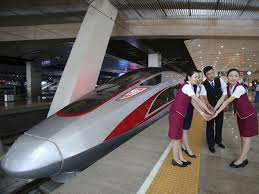China’s driverless can run up to 350 kilometers per hour

China has just hurtled past another milestone in its vast high-speed railway expansion plans. As the countdown to the 2022 Beijing Winter Olympics continues, the new 108-mile high-speed railway line connecting the capital with Olympic host city Zhangjiakou has just entered service, cutting the travel time between the two from three hours to 47 minutes.
This beauty, part of China’s Fuxing series, can run up to 350 kilometers per hour (217 mph) without a driver — said to be a world first. It’s also been dubbed the world’s first smart high-speed railway. Taking about four years to build, the line, also referred to as the Jing-Zhang high-speed railway, connects Beijing, Yanqing and Zhangjiakou, all three of which will host events during the upcoming Winter Olympics.
The route will stop at 10 stations, including Badaling Chang Cheng, the most popular section of China’s Great Wall. Chongli railway, a branch line from the Jing-Zhang railway, is also open and will ferry passengers from the capital city to Taizicheng Station — a stone’s throw away from several skiing competition venues and the Olympic Village. In the 1980s, Dong Yao-hui was part of the first three-man team to walk the entire length of China’s Great Wall. Today, he’s focused on its preservation.
The new rail line began operations on December 30, with the first train running from Beijing North Railway Station to Taizicheng Railway Station. A quick search on the official high-speed railway website 12306 China Railway shows there are currently about 30 bullet trains running between Beijing and Zhangjiakou daily but only six of them are serviced by the new “smart train”. Tickets range from RMB77 ($11) to RMB231($33) for a normal high-speed train and RMB90 ($12) to RMB270 ($38) if you’re traveling on a smart train. At the time of writing, tickets for the smart trains need to be booked two days in advance. So what makes them “smart?” Well, the carriages are equipped with 5G signals, intelligent lighting and 2,718 sensors to collect real-time data and detect any operational abnormalities. Meanwhile, each individual seat has its own touch-screen control panel and wireless charging docks.
Though the high-speed trains on the route are autonomous, a monitoring driver will be on board at all times. The trains can automatically start, stop and adjust to the different speed limits between stations. Back at the station, robots and facial recognition technologies have been deployed to help passengers with directions, luggage and paperless check-ins.





